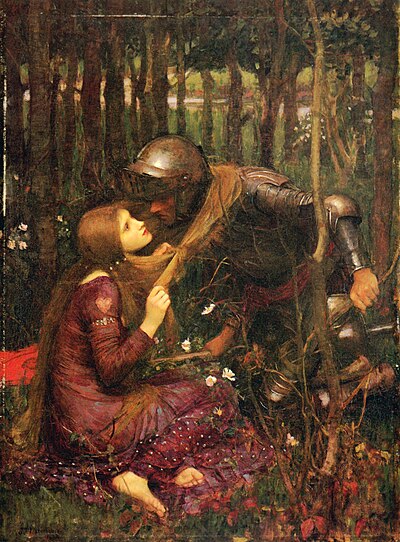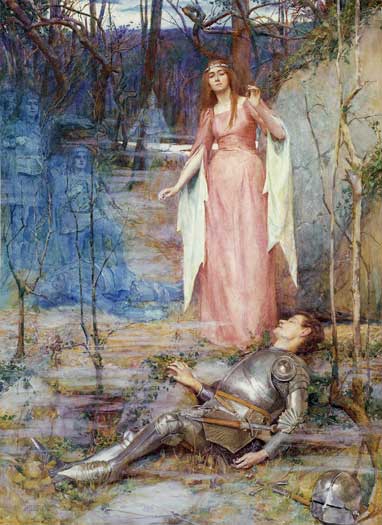September 14, 2021
|
O what can ail thee, knight-at-arms, |
Notes & Commentary
- ↑ Written in 1819, this ballad tells the story of haggard knight and his beloved: a fairy maiden who bewitches him then abandons him to a desolate landscape. This deceptively simple ballad conveys an air of mystery and barrenness in its four-line stanzas and shortened last line (Inglis 1969, p. 116). It mimics the traditional folk ballad’s dialogue form: the first three stanzas have the speaker asking the knight what ails him, and the remainder of the poem is his response (Greenblatt 2018, p. 497).
Here is a retelling of the myth of the femme fatale who destroys the life of the man who loves her (Greenblatt 2018, p. 497). I can’t help but think of Odysseus and Circe, as the latter seduces and keeps Odysseus and his crew on her island for a year, unable to continue their journey home, but also “in thrall”—keeping the men isolated and passive—unable to pursue their masculine aggression and violence world at large. Like Circe, the woman here has a power—whether it’s supernatural or just a product of her beauty and men’s lust is uncertain—and seems to represent the archetype of the fatal woman (Inglis 1969, p. 117). - ↑ Each stanza ends with a short, punctuated line that “augments the poem's air of inevitability . . . by substituting assertion for explanation: this is so because it has always been so, and no other cause need be sought” (Garrett (1987, p. 35)).
- ↑ The description and time of year, late-fall or early winter, suggests that the knight is past his youth, perhaps old. He is haggard—gray, gaunt, emaciated—and likely looking wraith-like—unlike the knights in the images to the right. The next stanza continues with images that also suggest age, decay, and death.
- ↑ The tense is wither’d replaces has wither’d from the first stanza, suggesting a timelessness and universality to the poem. This is but one example of the fluid use of tense in the ballad (Garrett (1987, p. 35)).
Bibliography
- Battenhouse, Henry M. (1958). English Romantic Writers. New York: Barron’s Educational Series, Inc.
- Bloom, Harold (2001). John Keats. Bloom’s Major Poets. Broomall, PA: Chelsea House.
- Frye, Paul H. (1987). "Voices in the Leaves: the 'Ode on a Grecian Urn'". In Bloom, Harold. The Odes of Keats. New York: Chelsea House. pp. 83–92.
- Garrett, John (1987). Selected Poems of John Keats. MacMillan Master Guides. London: MacMillan.
- Greenblatt, Stephen, ed. (2018). The Norton Anthology of English Literature. The Major Authors. 2 (Tenth ed.). New York: W. W. Norton.
- Inglis, Fred (1969). Keats. Arco Literary Critiques. New York: Arco.
- Nersessian, Anahid (2021). Keats’s Odes: A Lover’s Discourse. Chicago: The University of Chicago Press.
- Vendler, Helen (1983). The Odes of John Keats. Cambridge, MA: The Belknap Press.
- Wasserman, Earl (1964). "The Ode on a Grecian Urn". In Bate, Walter Jackson. Keats: A Collection of Critical Essays. Twentieth Century Views. Englewood Cliffs, NJ: Prentice-Hall. pp. 113–141.

